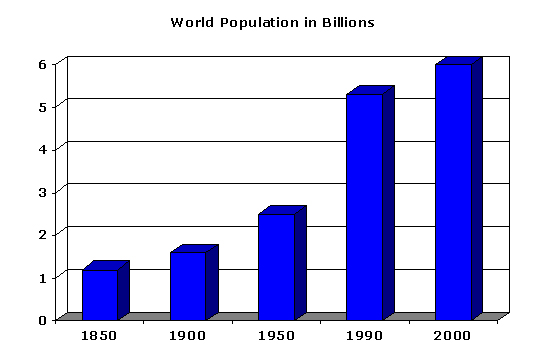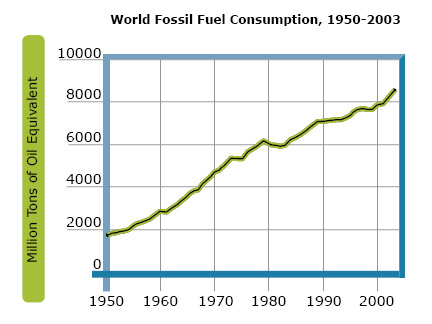|
|
||||||||||
|
||||||||||
|---|---|---|---|---|---|---|---|---|---|---|

|
||||||||||
Population growth and its environmental effects. Between 1955 and 1990, average life expectancies throughout the world also rose from about 35 years to 55 years. Approximately 6 percent of all the humans who ever lived on earth were alive between 1950 and 2000. And because of increased life expectancy, approximately 12 percent of all the years that all humans have ever lived were lived in those fifty years. The spread of new medicines such as antibiotics as well as improved sanitation and health care, especially in the world’s burgeoning cities, all played a role. Death rates declined throughout the world in both rural and urban regions, with some notable exceptions, such as the ex-Soviet Union. Agricultural changes, including increased irrigation, the use of artificial fertilizers and pesticides, and the development of genetically-engineered crops, ensured that food production kept up with global population growth. Agricultural production rose about 2.7 times between the 1950s and the 1990s, while population grew a little more than 2 times. The food chain, however, became much more vulnerable to widespread failure through its overdependence on energy-intensive agricultural practices and the increased dependency on globe-spanning chains of supply. Unprecedented population growth has magnified human impact on forests, croplands, pastures, and seas. These effects have been particularly devastating in poorer countries, which lack resources to limit environmental damage. The spread of human populations has threatened many species with extinction by reducing the land and resources available to them. In 1996, about 20 percent of all vertebrate species on earth may have been in danger of extinction. In fact, the rate of extinctions today may be approaching the rates attained in the five or six eras of most rapid extinction over the past several hundred million years.
Colossal energy consumption and the environment. Energy has been key to massive economic growth. Between 1950 and 2000, world energy consumption increased fourfold. The widespread use of petroleum and natural gas made unprecedented prosperity possible for some but also increased dependency upon non-renewable fossil fuels. Total world fossil fuel consumption increased from less than 2 billion tons in 1950 to 8 billion tons in 2000. With some notable exceptions, many parts of Africa and the global south, including Haiti, South Asia, and Brazil, continue to rely upon woodfires to cook meals, heat water, and warm homes. New technologies have increased the scale and transformed the nature of environmental change. By 1990, roads and other spaces set aside for automobiles and trucks took up 5-10 percent of the total land surface in North America, Europe, and Japan, and about 1 percent in the world as a whole.1 Modern transportation systems helped spread diseases such as AIDS, the SARS virus, and various types of influenza throughout the world within just a few years or even a few months. Scientists have created thousands of new chemicals, from plastics to fertilizers to chlorofluorocarbons (CFC). Many of these substances are harmful to humans and animals. By the 1970s, the Rhine river carried such high levels of chromium, nickel, copper, zinc, and lead that a Dutch expert complained that the river was “metal-plating Holland.”2 Increasing use of fossil fuels, particularly coal and oil, has pumped such huge quantities of carbon dioxide and other “greenhouse gases” into the atmosphere that these gases threaten to raise average temperatures and thus transform global weather patterns. “Global warming,” as this process is known, could have a devastating impact on low-lying areas, which are likely to be flooded as sea levels rise. Global warming may indeed transform the world’s climate. Nuclear power, which many at first saw as a source of virtually limitless clean energy, has turned out to be costly and dangerous. Its waste products not only take thousands of years to decay but also provide the raw materials for new and terrible weapons. No credible waste disposal system has yet emerged. Nuclear bombs have given humans the power, if they choose, to destroy much of the biosphere within just a few hours. For the first time in planetary history, a single species has become a major force for change in the biosphere as a whole. Though global in their scale, these environmental effects have differed from one region to another. Many of the wealthier industrialized nations have begun to reverse some forms of environmental damage by improving water and air, replanting forests, checking soil degradation in arid areas, and slowing the spread of infectious diseases. In dry and forest regions, however, farmers have often had to use the land in unsustainable ways merely to survive. Poorer countries have also found it harder to deal with diseases. The number of adults suffering from AIDS has been held below 1 percent in the US, but in some regions, the disease’s impact has been far more devastating. In the mid-1990s, for example, almost one quarter of all adults in Zimbabwe, Botswana, Namibia, Swaziland, and Zambia had the HIV virus that causes AIDS. While many in richer countries have begun to see environmental degradation as a future danger, many in poorer regions already live with environmental crisis. Global population growth has slowed since the 1960s because birth rates have fallen, particularly in the wealthiest and most urbanized regions. It now seems likely that human populations will level out at about 9 or 10 billion in the middle of the twenty-first century. In the long run, a slowing of demographic growth is bound to help reduce human impact on the environment. While the full consequences of humanity’s rapidly increasing impact on the biosphere are not yet clear, humans began for the first time in Big Era Nine to grapple with environmental problems at a global level.
|
Muslim travelers praying at Heathrow Airport, London. Photo by Ross Dunn |
 |
|---|
Global migration. Another prominent feature of this era has been the mass movement of people around the globe. The availability of cheap air travel, improved rail and road grids, and the relaxing of laws restricting movements in and out of countries have made this surge possible, while the search for jobs and opportunities has largely motivated it. For example, almost 13 million migrants moved to North America and Australasia between 1950 and 1973 alone. In that same period, Caribbean islanders migrated to Britain, Turks to Germany, Senegalese to France, Indians and Pakistanis to North America, Europe, and the Middle East. Chinese migrated to Xinjiang Province in the far west of the country and to Inner Mongolia. Russians moved to the steppes of Kazakhstan.
Electronic communications. Perhaps more remarkable has been the impact of telecommunications and the digital revolution. By 2000, more than 1 billion phones were in use throughout the world, and several hundred million computers were linked to the Internet. The spread of mass media—newspapers, cinema, radio, television, and the Internet—ensured that images, news, and advertising also became global. Turkmen nomads in Inner Eurasia use satellite dishes to watch American soap operas, and young women and men throughout the world, responding to images of life in the US, began to wear baseball caps backwards. As the philosopher Marshall McLuhan predicted in the 1960s, the world seemed to be turning into a single “global village.”
Postwar economic growth and trade. Globalization has been closely linked to economic growth. Between 1950 and 1973, global GDP grew almost 5 percent per year before falling to the still respectable rate of 3 percent after 1973. In just under fifty years, global GDP multiplied by more than six times. There were many causes of growth. The major capitalist powers deliberately engineered a revival of world trade after World War II, focusing primarily on Europe and Japan. The US pumped huge amounts of money into the reconstruction of both regions, and the major states collaborated to create an international financial system linked to the United Nations via the Bretton Woods Accords (1944).
As a result, international trade revived rapidly after the war. The volume of goods traded on international markets, which had fallen between 1913 and 1950, tripled between 1950 and 1995. As rural workers migrated to towns and as more and more women took up paid employment, the number of wage earners grew by leaps and bounds. This was even true for a time in the communist world, where high rates of growth in the 1950s and 1960s depended mainly on government-led industrialization drives. Chinese growth rates rose from 2.9 percent per year between 1950 and 1973 to 6.4 percent for most of the 1990s.
The benefits of growth, however, have been distributed unevenly. Living standards rose most rapidly in the industrialized capitalist regions and to some extent in Russia and China but more slowly in much of the developing world. After the Great Depression, capitalist governments and producers learned how important it was to sustain demand by ensuring that consumers could keep buying things. The importance of mass markets for goods such as refrigerators, televisions, and cars first became apparent in the US between the two world wars. After World War II, mass consumption of these and other goods also helped sustain growth in other capitalist economies, especially during the boom years before the 1970s. In the wealthier countries, rising living standards have also helped to defuse political radicalism and maintain the stability of democratic institutions.
For consumers in the richest nations, these changes have brought an unprecedented rise in living standards. In the world as a whole, however, economic differences between richer and poorer regions have become greater than ever, especially in the later 1970s, when the world economy slowed. The table below reveals these differences.
Per Capita Gross Income in 2000 (in $US)
USA |
34,100 |
|---|---|
Countries of highest income (average) |
27,680 |
Brazil |
3,580 |
China |
840 |
India |
450 |
Burkina Faso (Upper Volta) |
210 |
Economists in the wealthier regions kept insisting that eventually even the poorest areas would benefit from the dynamism of world capitalism. While China, Taiwan, South Korea, and India experienced industrial growth, this was not the case in much of Asia, Africa, and Latin America, which chiefly participated as sources of cheap raw materials. They gradually became deeply indebted to banks and governments in wealthier regions. By the 1970s world growth stagnated and even began to fall, particularly in parts of Africa and Latin America. Despite rapid world economic growth in the first part of the era, many were left behind. As late as 2002, 3 billion people had never used a telephone, and 1 billion people had no access to electricity.3
The Cold War and its end. During Big Era Nine, the Cold War (1944-1991) dominated world politics. This was a struggle in which many of the world’s states clustered into one of two hostile blocs, one claiming to represent capitalism, the other communism. Fears of the spread of communism raised tensions throughout North America and Western Europe. In Russia, China, and Eastern Europe, communism sealed off a generation from the West, while facilitating state-led economic modernization. The Cold War also had a major impact upon the colonized territories of Asia, Africa, and Latin America, most of which obtained their independence in this era. Both of the power blocs sought out leaders of nationalist movements and new states to be their political clients, and they both supported propaganda wars to attack the beliefs and values of the other side. China, India, Cuba, Egypt, and many other countries benefited from Soviet aid, normally directed at large construction projects, for example Egypt’s Aswan dam on the Nile. While Europe and Japan benefited from massive US reconstruction loans after the war, other countries experienced a stifling lack of progressive change as their big power patrons sought to maintain the status quo. One example was Soviet domination in Angola, a mineral rich country that remained desperately poor. Another was South Africa, where the racist minority government trumpeted its staunch anti-communism, discouraging the US and its allies from challenging the apartheid system. It seems likely that global inequalities were enhanced as a result of the Cold War. Much time was lost in the race to development.
Fidel Castro and his ally Nikita Khrushchev at the United Nations, 1960. Library of Congress Prints and Photographs Online Catalog Reproduction number LC-USZ62-127229 |
 |
|---|
Following the end of the Cold War in 1989, the Soviet Union broke up into more than a dozen new states, and eastern European states abandoned their Moscow-loyal communist governments. The world economy was once again integrated, as it had been in the late nineteenth century, into a single international system dominated economically by market capitalism. Even China took an increasingly active role in world trade. The dominant nation in the system was now the US, but its power did not go unchallenged. The economic and political influence of Europe grew as nations there formed the European Union. Economic growth in China and India gave those countries new political clout, and the new Russian Federation, smaller than the Soviet empire but still in possession of a nuclear arsenal and huge oil reserves, could not be ignored.
Sovereignty and rights. Another major political focus of this era was decolonization. Independence movements sprang up around the globe, and European empires crumbled one after another. Although several colonies (especially in Southeast Asia and Africa) won their freedom through constitutional change backed by vigorous political action and protest, others including Algeria, Vietnam, Afghanistan, and the Portuguese colonies in Africa, fought prolonged and bloody revolutionary wars against their colonial masters.
The last half of the twentieth century witnessed not only the triumph of anti-colonial nationalism all across the globe, but also the assertion of global human rights, as embodied in the United Nations Universal Declaration of Human Rights of 1948. The UN established a Commission on Human Rights (CRC) based in Geneva, together with the High Commissioner for Human Rights. On March 15, 2006, the United Nations Human Rights Council (UNHRC) was established as a further demonstration of the seriousness of the UN’s commitment to global human rights. The efforts of the UN over the past half century have led to the increasing recognition of the existence of global human rights as a standard by which to measure national and local practices.
The UN Declaration of Human Rights of 1948 had important consequences across the entire spectrum of rights. For example, the assertion of rights of children dates to a 1923 League of Nations declaration. The 1989 UN Declaration of the Rights of the Child (CRC) strongly supported children’s rights and established a number of international bodies charged with their enforcement. Finally, against the background of increasing evidence of slavery and human trafficking, the world has been more alert to the fact that bonded servitude, believed to have been formally abolished in the nineteenth century, was spreading once again. Various agencies, including UNESCO, the International Labor Organization and Anti-Slavery International have endeavored to document slavery and to enforce laws against it around the world.
The passing of peasantries. Big Era Nine represented the near destruction of the world’s rural peasantry. For thousands of years, most people in the world had been peasants farming small areas of land. Following the Industrial Revolution, however, more and more peasants become wage earners. They either stayed in rural areas to work for commercial farmers, or they left for the major towns in search of wage work. The decisive changes occurred in this era when peasants came to represent a minority of the world’s population. Between 1950 and 2000, the number of people living in cities rose from about 30 percent to over 50 percent. In Japan, the number of farmers fell from over 50 percent of the population in 1950 to less than 10 percent in 1985. In Colombia, Brazil, and Mexico, the percentage of farmers fell by half within just twenty years. By the late 1980s, peasants remained a majority of the population only in Africa south of the Sahara, South and Southeast Asia, and China. Even in those regions, the proportion of rural farmers fell rapidly. The “death of the peasantry” meant the end of a way of life that had shaped the experiences of most humans since the agricultural revolution 10,000 years earlier.
Students at the American University of Sharjah in the United Arab Emirates. This coeducational university, founded in 1997, follows an American model of higher education. Photo by Ross Dunn |
 |
|---|
Women’s rights. Women have made major gains in Big Era Nine in the long march for rights and equality. A major benchmark was the 1948 United Nations Convention on Human Rights, which declared “the equal rights of men and women.” A UN Commission on Women’s Rights has held regular conferences since its foundation in 1946. In 1979, the Convention on the Elimination of All Forms of Discrimination Against Women (CEDAW) was enacted. A Convention on the Elimination of All Forms of Discrimination against Women came into effect in 1981. Women now possess the right to vote in most countries in the world. With some exceptions their right to own property is also widely recognized, though the disinheritance of women is still practiced in many peasant societies. Finally, women have had their reproductive rights recognized, a process in which the World Health Organization has played an important role even if they are not always able to exercise those rights in many societies. From the vantage point of the early twenty-first century, advances for women in Big Era Nine were impressive compared to any earlier era, but universal rights and equality are still far from full realization.

Humans and Ideas 
The relationship between humans and ideas was transformed in previously unimaginable ways during this era. The advent of universal primary schooling, the modern telecommunications media and the unprecedented movements of people and ideas around the planet linked the world’s peoples more closely, even while they reinforced differences between and among them. As a consequence, modern science, religion, and popular culture have all acquired an unprecedented ability to influence our lives.
Environmental consciousness. A major arena of increased global consciousness since 1950 has been the natural and physical environment. As people have become exposed to the increasingly convincing scientific data supporting the idea of global warming, they have sought to protect natural resources and ecosystems. Today large and diverse numbers of national and international environmentalist organizations seek to encourage public awareness and action around environmental issues. Cumulatively these have generated a global conversation out of which some important institutions have emerged. One sign of this was the United Nations Conference on Environment and Development in 1992. As more people become aware of the interconnected strands that tie together the local and the global, an environmental consciousness has begun to emerge.
There have been some notable successes in the campaigns to protect the environment. They are often initiated by local communities and aimed at conserving local resources such as fresh water forests. On occasion, wealthier and poorer regions have cooperated successfully to deal with environmental problems that affect the entire world. In the 1980s, for example, it became clear that the release of CFC chemicals used mainly in refrigeration threatened to break down the thin ozone layer that shields the earth from the sun’s ultra-violet radiation. In 1987, an international agreement limited the production and use of CFCs, and it seems that the ozone layer may be repairing itself as a result. New energy technologies, such as wind power and hydrogen fuel cells, may eventually help reduce our dependence on fossil fuels.
Global culture. The globalization of the world economy has transformed the way in which nearly everyone thinks about the world. At the level of popular culture, the world is more homogenous because styles, tastes, and material goods from the more industrialized countries have spread to the rest. For example, the McDonald’s chain of fast-food restaurants, which first opened in the US in 1955, now has thousands of outlets throughout the world, selling variations on the same basic menu. Clothing manufacturers create styles for a global market. Popular music in a myriad of different languages and styles attracts audiences around the world. Similarly, major movies are now filmed with global audiences in mind, not just national ones. In much of the world, cultural change reflects a complex synthesis of the traditional and the modern, the local and the Western. Little of this could have been predicted before 1950.
 |
|---|
A Crowded McDonald’s Restaurant in Moscow, 2003. Photo by Ross Dunn |
Marxism and Neo-Liberalism. The rise of neo-Liberal thought and the decline of Marxism are two other major developments of the period. The Marxist intellectual tradition presented a powerful intellectual critique of capitalism in the Cold War era. At its apex in the 1970s, that tradition inspired hundreds of thousands of intellectuals, artists, and political activists in Europe, Asia, Africa, and the Americas. With the fall of the Soviet Union and the increasing complexity of the capitalist world economy, Marxism was widely discredited as a belief system. Neo-Liberalism, which preached the inevitable triumph of market forces, seemed to sweep all before it. At the end of the twenty-first century’s first decade, however, the broad claims made by neo-liberal economists and politicians fell into question once again as the world plunged into a severe recession.
Christ Taken Down from the Cross Stained Glass, Anglican Cathedral, Harare, Zimbabwe. Photo by Ross Dunn |
 |
|---|
Religion and science. As people throughout the world encountered one another’s beliefs and values, the deepest ideas about the meaning of life have been challenged. All religions have rethought their relationships to other religions and to the secular and scientific traditions of the twentieth century. Many small, localized belief systems have died out. Major religions have also been transformed. For example, Christian music today owes a huge debt to African and African American musical traditions. Increased literacy and mass communication have helped some faiths to expand to new areas and to generate renewed commitments among their faithful. Modern media have enhanced the Pope’s authority and prestige among Roman Catholics, and the pilgrimage to Mecca is now accessible to millions of Muslims, who fly to the sacred sites in Saudi Arabia from around the world.
But even as religion plays a large role in our world, so too does science. Beginning in Big Era Seven, modern science presented a formidable challenge to religious faith. The prestige of modern science derives from its universality. For all its achievements, however, science remains a rapidly evolving tradition. In Big Era Nine, fundamental new ideas, or “paradigms,” emerged in several crucial disciplines, including cosmology, nuclear physics, biology, and geology. In cosmology, the “Big Bang Theory” provided an explanation of the origins of the universe. Physicists have gained deep understanding of the nature of sub-atomic particles. Biologists now grasp the role of DNA in evolutionary change. In geology, the theory of plate tectonics has provided a platform for new understanding of the development and evolution of life. As a result, scientific explanations of long-term cosmological, geological, and biological change have become increasingly well established.
The successes of science have also led to new problems. The biotechnological revolution gave scientists the ability to manipulate genes and, in principle, to clone (make genetic duplicates of) animals, including human beings. Should such techniques be used? What might the consequences be? Should humans tinker with life and death in such fundamental ways? Similarly, the spectacular power humans now have over the environment poses new challenges. Should we restrain our consumption to save the environment, even if this means reducing living standards in wealthier countries and slowing, rather than speeding up, the development of poorer countries? Is it legitimate for any country to arm itself with nuclear weapons whose release would spell disaster for everyone?
Big Era Nine has been an era of staggering change and has left us with more questions than answers. Perhaps the most important question is whether or not humans will succeed at managing a global system that, as the twenty-first century moves ahead, is both complex and fragile.
Teaching Units for Big Era Nine
Definition of Panorama Teaching Units
9.0 |
Paradoxes of Global Acceleration |
PowerPoint Overview Presentation: |
Complete Teaching Unit Download Options:
|
Definition of Landscape Teaching Units
9.1 |
World politics and global economy after World War II |
||
|---|---|---|---|
9.2 |
The two big powers and their Cold War |
||
9.3 |
A multitude of sovereign states |
||
9.4 |
Wealth and poverty since 1950 |
||
9.5 |
The world at warp speed: science, technology, and the computer revolution |
||
9.6 |
Population explosion and environmental change since 1950 |
||
9.7 |
Globe-girdling cultural trends |
Definition of Closeup Teaching Units
3.2.5 |
Korea |
||
9.7.1 |
1968: A Year of Global Protest |
Footnotes:
1 J. R. McNeill, Something New under the Sun: An Environmental History of the Twentieth-Century World (New York: Norton, 2000), 311.
2 J. R. McNeill, Something New under the Sun: An Environmental History of the Twentieth-Century World (New York: Norton, 2000), 132.
3 J. R. McNeill and William H. McNeill, The Human Web: A Bird’s Eye View of World History (New York: Norton, 2003), 316.
Note:
Documents in Portable Document Format (PDF) require Adobe Acrobat Reader 5.0 or higher to view, download Adobe Acrobat Reader.
Documents in Powerpoint format (PPT) require Microsoft Viewer, download powerpoint.
Documents in OpenOffice format (ODT) require Oracle OpenOffice, download Oracle OpenOffice.
Documents in Word format (DOC) require Microsoft Viewer, download word.
|
World History for Us All is a project of the UCLA Department of History's
Public History Initiative, National Center for History in the Schools. Project Support | Conditions of Use |

